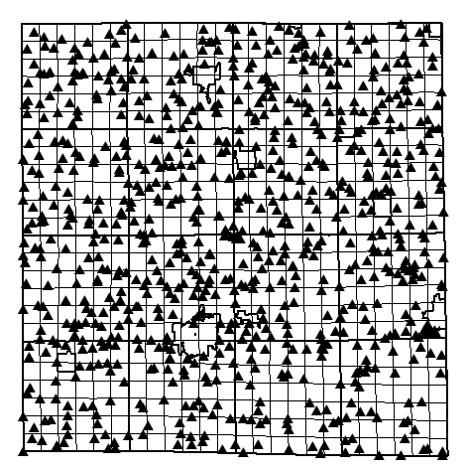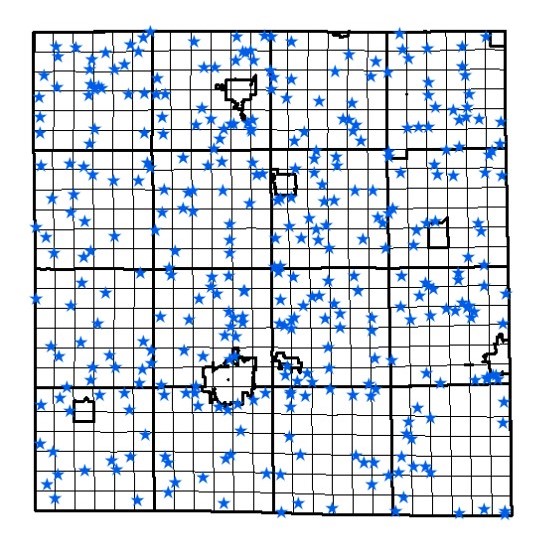Groundwater Quality Trend Data Program
Green County is starting a five year groundwater quality trend data project. It is one of the first counties in Wisconsin (and nationally) to use the process it is using. This is an exciting opportunity to learn more about groundwater in Green County. This multiyear process is specifically designed to get good data in order to better understand water quality in Green County.
Tracking groundwater quality trend data will help local officials and Green County residents make data-driven decisions when managing groundwater quality. Currently, little information exists that allows for an understanding of how groundwater quality has changed over time in Green County. Establishing a network of private well owners to perform annual testing over an extended period of time will help inform residents and local leaders whether groundwater quality is getting better, worse, or staying the same.
What tests are being taken?
Confidence in this trend data enables isolating areas where nitrate, chloride, and alkalinity are increasing or decreasing.
Nitrate
Nitrate is an important test for private well owners. Levels greater than 10 mg/L nitrate-nitrogen should not be consumed by infants, women who are or trying to become pregnant.
Nitrate is a chemical commonly found in agricultural and lawn fertilizer. It is also produced when organic rich materials such as manure, bio-solids, septic system effluent, etc decompose. Nitrate is a very soluble form of nitrogen and can easily leach past the root zone of plants into groundwater. Levels of nitrate in groundwater are generally less than 1 mg/L in natural or areas of little human influence. Elevated levels generally occur in areas of agricultural activity or areas of dense rural development (ie.small lot sizes with septic systems, lawn fertilizers, etc). Soils and geology make certain areas more prone to nitrate losses to groundwater. For these
reasons, nitrate is a good test to perform if trying to understand the impacts of land use on groundwater quality as well as trends over time.
Chloride
Like nitrate, chloride is a useful tool for understanding the impacts of land use. Major sources of chloride to groundwater include fertilizer, road salting and septic system drainfields. Potash is used to add potassium to soil. The most common form of potash is potassium chloride; the chloride is susceptible to leaching. Road salt (usually sodium chloride) helps in deicing roads, but is then washed off roads into ditches or other pervious areas where it soaks into the soil and can eventually leach to groundwater. Septic system drain fields dispose of wastewater which contains chloride from human waste and water softener salt.
Alkalinity
Alkalinity is a measure of water’s ability to neutralize acid. It is generated by the dissolution of carbonate minerals common to Wisconsin. Groundwater alkalinity measurements are relatively stable from one year to the next. Testing for alkalinity would help in understanding if a particular sampling event was influenced by rainfall or snow melt because alkalinity should be relatively consistent under normal conditions.
Where are tests being taken?
Well Selection and Recruitment
A total of 778 wells were selected as part of the initial recruitment (Figure 1 below). This assumed a response rate of approximately 35%. Wells were selected using a variety of datasets that included the Wisconsin Parcel Data Layer, Well Construction Records, Center for Watershed Science and Education Well Water Data, and others.
Figure 1.
Black triangles represent 770 well parcels that were mailed recruitment materials.

For the initial recruitment list, an attempt was made to locate at least one well owner per section with a Wisconsin Unique Well Number and could be matched to a landowner from the parcel data layer. All things being equal, preference was given to those landowners that participated in previous Extension well testing efforts. Most wells on the list have well depth, well casing, and water table information. Of the landowners that were contacted, 114 submitted a previous sample through Extension programming.
Recruitment materials consisted of a recruitment letter describing why the landowner was being contacted along with additional information about the project. Landowners were asked to respond using a pre-paid postcard. Recruitment materials were mailed in early November 2019.
Recruitment Response/Participants
A total of 388 landowners indicated their willingness to participate in the well monitoring program (Figure 2 below). This is a success rate of 49.8%, higher than the initial estimate of 35%. Anticipating a drop in participation over the 5 year period, the Center for Watershed Science and Education plans to sample all 388 wells the first year in hopes that there is still a minimum of 240 well samples by the end of the final year of the project.
Figure 2.
The blue triangles indicate the location of well parcels (388 / 49.8%) that have agreed to participate.

What are the results from Year 1 (2019)?
Each individual participating homeowner received their specific results back in April 2020. Kevin Masarik with the UW-Stevens Point Center for Watershed Science and Education, held a virtual educational session for participating homeowners in June 2020. A recording of that session is available: Green County Well Water Monitoring Program 2020 (live recording).
Kevin also provided the Green County board with an annual report in July 2020. That report provides the aggregated data. Green County Board Annual Update Report – July 2020
Because 2020 was the first year with this multiyear program, the 2020 tests helped in getting an understanding of where things were currently at when it comes to nitrates in groundwater in Green County.
The Year 1 results are complete and were presented to the Green County Board on August 12, 2020. Please view the Presentation to Green County Board-Condensed Version 20200812 for more information.
Read the Green County Well Water Monitoring Program’s Year One Results- Press Release regarding the results from Year 1 (2020) of this project.
What are the results from Year 2 (2020)?
In mid-November 2020, sample kits were mailed out to 342 participants. The deadline for returning the kits to the UW-Stevens Point Center for Watershed Science and Education was December 15, 2020. Approximately 314 tests were submitted, and participants received their individual test results in early February.
Kevin Masarik, Groundwater Education Specialist with the UW-Stevens Point Center for Watershed Science and Education, held a virtual educational session for participating well owners in late February 2021. A recording of that session is available: Green County Groundwater Quality Trend Data Program Year 2 Presentation (live recording).
Kevin also presented to the Green County Board on May 11, 2021 (Presentation Slides: Green County Well Water Monitoring Program Year 2) and provided the Green County board with an annual report in June 2021. That report provides the aggregated data. Green County Board Annual Update Report — June 2021.
In addition to the report to the Green County Board is an interactive website (Green County Well Water Monitoring Project Website) that makes it possible to delve deeper into the results. Additional functionality will be added in 2021 that looks at relationships to various well factors (ex. casing depth, land-use, soils, geology).
Read the Green County Well Water Monitoring Program’s Year Two Results Press Release regarding the results from Year 2 of this project.
What are the results from Year 3 (2021)?
In mid-November 2021, sample kits were mailed out to 323 participants. The deadline for returning the kits to the UW-Stevens Point Center for Watershed Science and Education was October 22nd, 2021, all samples received before December 1st, 2021 were analyzed. A total of 307 samples were submitted, and participants received their individual test results in early February 2022.
Kevin Masarik, Groundwater Education Specialist with the UW-Stevens Point Center for Watershed Science and Education, held a virtual educational session for participating well owners in late February 2022. A recording of that session is available: Green County Groundwater Quality Trend Data Program Year 3 Presentation (live recording).
Kevin presented to the Green County Board in June 2022 the Green County Well Water Monitoring Program 2021 Report Results to share a report with aggregated data. He gave additional information with the Green County Board Water Trend Annual Updated Report June 2022. In addition to the report to the Green County Board is an interactive website (Green County Well Water Monitoring Project Website) that makes it possible to delve deeper into the results.
What are the results from Year 4 (2022)?
In mid-November 2022, sample kits were mailed out to 323 participants. All samples received before December 1st, 2022 were analyzed. A total of 294 samples were submitted, and participants received their individual test results in early February 2023.
Kevin Masarik, Groundwater Education Specialist with the UW-Stevens Point Center for Watershed Science and Education, held a virtual educational session for participating well owners in late February 2023.
Kevin presented to the Green County Board in June 2023 the Green County Well Water Monitoring Program 2022 Report Results to share a report with aggregated data. He gave additional information with the Green County Board Water Trend Annual Updated Report June 2023. In addition to the report to the Green County Board is an interactive website (Green County Well Water Monitoring Project Website) that makes it possible to delve deeper into the results.
What are the project deliverables?
This groundwater quality trend data program will result in the following project deliverables:
- A mid-year progress report will be provided to Green County describing activities during the first 6 month period. View the Green County Groundwater Quality Trend Data January 2020 Report.
- An annual in-person update and educational session/open house event.
- An annual report will be provided to Green County at the completion of each year summarizing results from the annual testing.
- After each well test, each well owner will receive a copy of their individual test results along with interpretive information.
- An online interactive data visualization tool will be developed to catalogue data and make available to the public and county for outreach/educational purposes.
- Data will be archived in the Center for Watershed Science and Education database which can be queried or summarized upon request.
- Any databases, raw data files, or other electronic files generated as a result of the project will be provided via preferred format to Green County.
This website will be updated when additional/new information is available.
Frequently Asked Questions
Why can’t the data used from regularly tested dairy farms work for trend data?
They are only required to test for bacteria. Additionally, this would rely on farmers voluntarily sharing that information since this information is not required to be shared publicly or currently maintained in a database.
Is this duplicating monitoring wells?
Monitoring wells are often used to measure field scale or site specific problems. For example, if you suspected that a landfill or manure storage facility were leaking, a network of monitoring wells adjacent to the site would be the appropriate strategy to answer that question.
The intent of this project is to learn about groundwater quality more generally across all of Green County. As a result, it is important to design a network that is representative of a broad range of factors (such as soils, geology, land use, depth, etc) that are likely to contribute to quality of rural residential wells in the area being studied.
Would it be possible to keep weather data alongside the data and use that to help understand the data and possible implications?
Yes. If there are quality weather stations that are providing publically available data, it is possible to summarize annual and/or monthly weather data in the annual report or other outreach/educational materials.
Questions? Contact:
- Victoria Solomon, Community Resource Educator, Extension Green County at (608) 328-9440 or victoria.solomon@wisc.edu.
- Kevin Masarik, Groundwater Education Specialist, UW-Stevens Point & UW Madison Division of Extension, at (715) 346-4276 or kmasarik@uwsp.edu.




